150th Anniversary History Timeline
-
1865
Indiana General Assembly Votes to Participate in Morrill Act
Just before the surrender of the Confederate army at Appomattox, the State Legislature accepts the act’s provisions to form Indiana’s land-grand institution, which would later become known as Purdue University.
-
1874
Engineering's Beginning
University President Shortridge establishes the first four-year courses of Civil and Mechanical Engineering at Purdue.
-
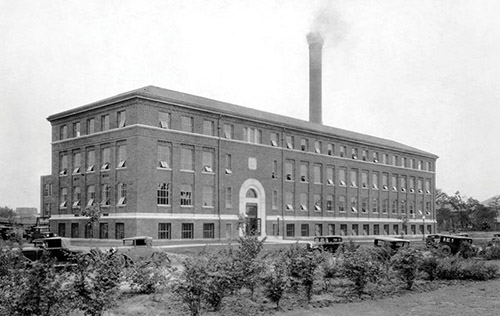
1882
School of Mechanical Engineering Established
Purdue’s first engineering school forms with not even one of Purdue’s 90 total students qualified to take an engineering course from the university’s one engineering instructor. In 2024, Purdue’s online graduate program in Mechanical Engineering was ranked #1 by U.S. News & World Report.
-

1887
School of Civil Engineering Established
The school forms with 29 students headed by one professor. The Purdue Road Show was launched in 1915 as part of the school.
-
1888
Elwood Mead (BSAg 1882, MSCE 1888, Honorary Doctorate)
Mead is Purdue agricultural engineering’s first graduate and later received Purdue’s first honorary doctorate. He went on to become the chief engineer behind the construction of the Hoover Dam, which was completed in 1936. The dam's reservoir -- the largest man-made reservoir -- bears his name, Lake Mead.
-
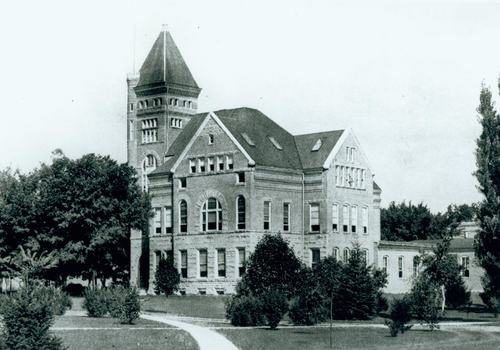
1888
School of Electrical Engineering Established
School forms with concentration in power generation and distribution. Paul McEnroe (MSEE ’60) while working as a lab director at IBM, made a bigger difference worldwide than even he might have imagined as a student. The globally ubiquitous barcode that appears on almost all products worldwide, was created, developed and produced by McEnroe and a team he formed and managed at IBM.
-
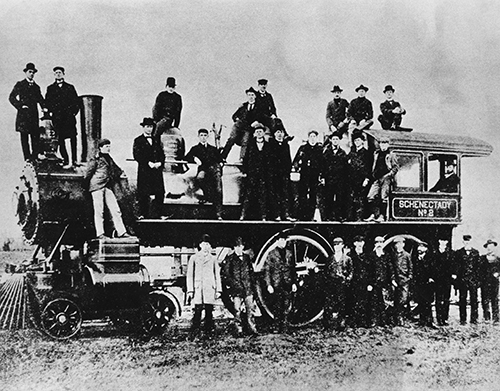
1891
Arrival of Original "Boilermaker Special"
The 85,000-pound test locomotive Schenectady, the original "Boilermaker Special," arrives at Purdue to be used in the world's first locomotive testing lab.
-
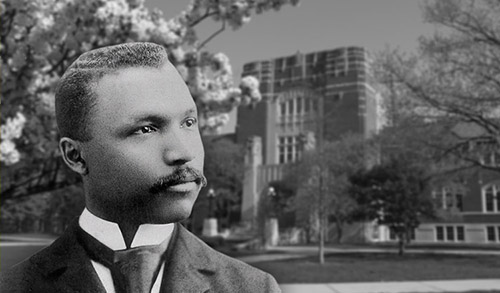
1894
David Robert Lewis (BSCE 1894)
Purdue's first African American engineering graduate. From 1894 to 1906 he would hold the position of mechanical drawing instructor at Armstrong & Slater Memorial Trade School at Hampton Normal and Agricultural Institute in Virginia. Later, he would start a successful career as real estate broker in Pittsburgh.
-
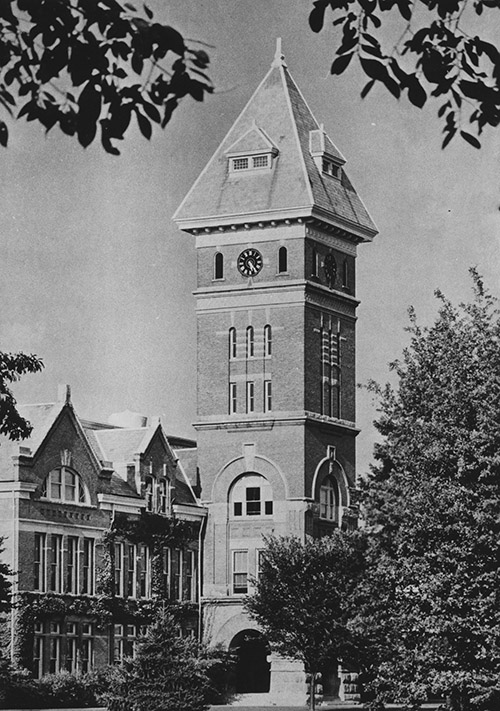
1894
Heavilon Hall
Construction is completed on the new home for Purdue engineering. Four days later, the building would burn to the ground. University President James A. Smart would have tears in eye watching it go from flames to ash in the night.
-
1895
One Brick Higher
Heavilon Hall in the early 1900s, after it was rebuilt following a fire that destroyed it in January 1894, just four days after it was initially built. The campus’s resilience in the face of adversity gave rise to the often-used phrase, "one brick higher," which refers to President James Smart’s fulfilled vow to rebuild Heavilon following the fire that destroyed it.
-
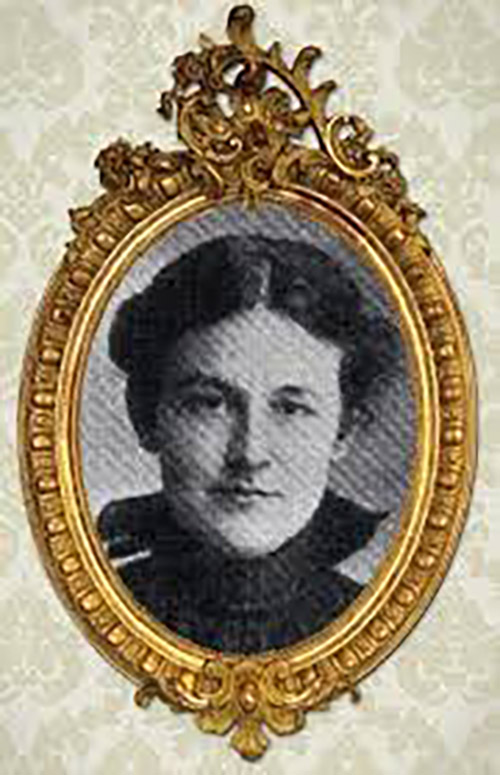
1897
Martha Dick Stevens (BSCE 1897)
Purdue’s first female engineering graduate, earning a Bachelor of Science in Civil Engineering and a Master of Science in 1898.
-
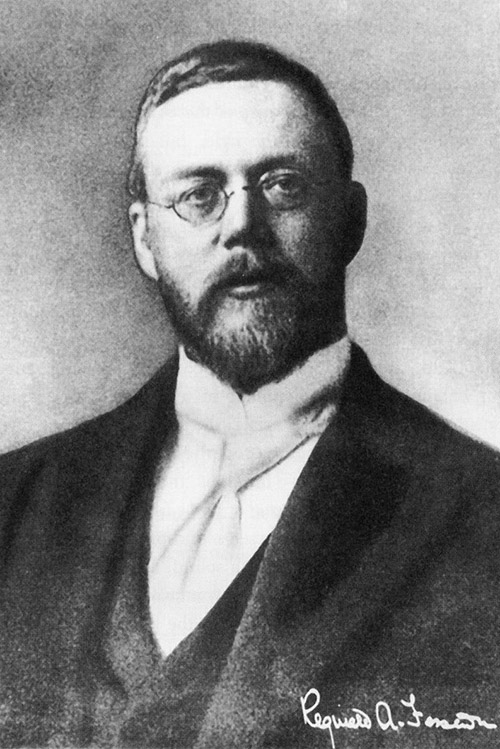
1900
Father of Radio Broadcasting
Reginald Fessenden succeeds in sending the first wireless transmission of the human voice-radio as we know it today. He would later be known as the father of radio broadcasting. In 1892 Fessenden was appointed as a professor for the newly formed Electrical Engineering Department at Purdue and became the third head of Purdue ECE.
-
1906
Civil Engineering Building
What would be renamed Grissom Hall, is built to house the increasing number of students in the growing school. In 2024, U.S. News & World Report ranked Civil Engineering’s online graduate program #2 and its undergraduate program #4 in the U.S.
-
1911
School of Chemical Engineering Established
During the first years, the school would require students to read, write, and understand German, since the major advances in the field came mostly from Deutschland. A campus-wide IQ test in 1919 would reveal that the seniors in the school had the highest average IQ, 135, of any group on campus.
-
1925
Agricultural Engineering
Takes on the task of bringing the Industrial Revolution to agriculture. Some of the first acts would prove the effectiveness of tractors to Indiana’s farmers and prove to farmers and power companies the efficiency and need for using electricity on farms. U.S. News & World Report has ranked the school’s undergraduate and graduate programs #1 for multiple years.
-
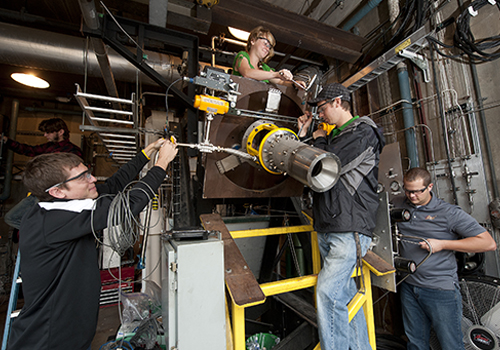
1928
Maurice Zucrow (PhD’28, Honorary Doctorate ’70)
Received the first doctorate granted by Purdue. Zucrow Labs is named in honor of the world-renowned research who conducted rocket-engine studies in the ‘40s and ‘50s at Purdue’s Jet Propulsion Center.
-

1935
Lillian Gilbreth: Pioneered the Discipline of Industrial Engineering
Lillian Moller Gilbreth was an industrial engineer and efficiency expert who became Purdue’s first female engineering professor when she joined the faculty in 1935. Her research focused on combining psychology and engineering to improve efficiency in the workplace and home, pioneering the field now known as ergonomics. Professor Gilbreth’s family life with her husband and research collaborator Frank and their 12 children is the subject of the autobiographical novels “Cheaper by the Dozen” and “Belles on Their Toes,” which were written by two of their children and describe how the Gilbreths applied their efficiency studies in their home. Gilbreth was the first woman inducted into the National Academy of Engineering.
-
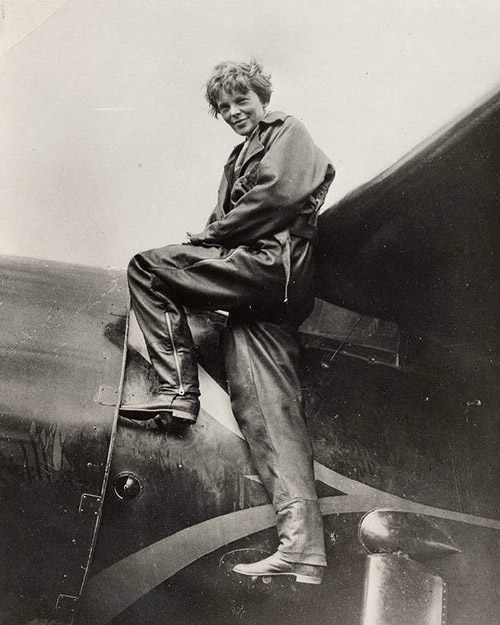
1935-37
Amelia Earhart: Aviator. Legend. Boilermaker.
Amelia Earhart was an instructor and advisor in careers for women at Purdue from 1935-37. At a time when opportunities for women were limited and most studied home economics at Purdue, Earhart said all people — women and men — could be whatever they wanted to be. Earhart also flew out of Purdue University Airport in the 1930s, when it became the nation’s first university-owned airport. A new terminal at Purdue University Airport will be named in 2024 to honor this legendary Boilermaker aviator.
-
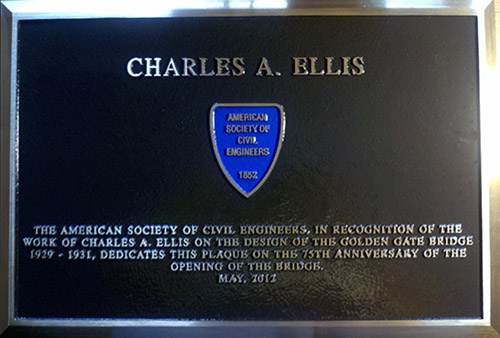
1937
Golden Gate Bridge
Charles Ellis, a Purdue civil engineering professor from 1934 to 1946, was finally recognized as the true designer of the Golden Gate Bridge with a plaque installed at the bridge in 2023. Because of a dispute with Joseph Strauss, he wasn’t recognized for his work when the bridge opened in 1937.
-
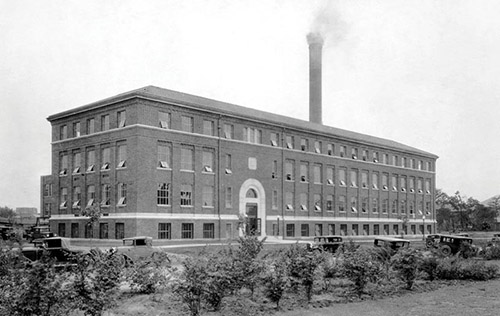
1942
School of Mechanical and Aeronautical Engineering Established
Dean Potter decided by mid-1941 that aeronautical engineering should play a key role in Purdue's growing war training effort. Under his leadership, the School of Mechanical Engineering changes its name and begins the university's first, four-year BS curriculum in aeronautical engineering. During the war, aero engineering would work in conjunction with the armed forces and war industry to create specific training programs: the Air Corps Cadet Aeronautical Engineering Program, the Curtiss-Wright Cadette Programs to train young women for technical positions normally help by men at the airplane corporation, and the Navy V-12 Program.
-
1945
School of Aeronautics Established
Aeronautics moves into its own program about a month before the war ends with Japan. With WWII, aircraft has proved to the world their lasting importance. The board of trustees selects the title School of Aeronautics because the school would offer degrees in both aeronautical engineering and air transportation; being one of only two institutions in the U.S. to offer the two options. The 1956, the school would become known as the School of Aeronautical Engineering, dropping the transportation degree.
-
1949
Iven C. Kincheloe Jr. (BSAE ’49)
Would become U.S. Air Force test pilot who flew the X-2 to 126,000 ft. in 1956, nearly becoming the first man in space. Would be selected to fly X-15 to become first American in space but was killed in another test flight July 26, 1958.
-
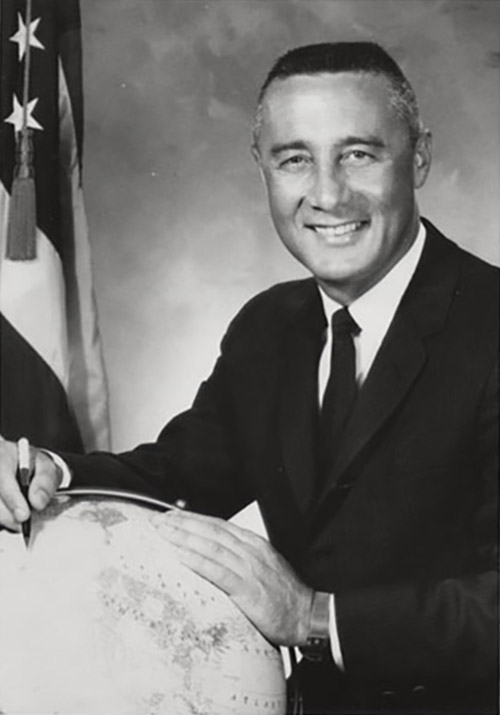
1950
Virgil "Gus" Grissom (BSME ’50)
Would be in the first group of astronauts in 1959; second man in space, piloting Mercury Redstone 4 in 1961; command pilot for Gemini 3, the first two-person space flight; and would eventually die while serving his country on Jan. 27, 1967, in the Apollo 1 flash fire at Cape Kennedy.
-
1953
Freshman Engineering
First program of its kind in the country. It would provide a plan of study that would stimulate interest in engineering careers and enable freshman to continue their course as upperclassmen at such a level as to provide the profession with the best prepared young engineers to be found anywhere.
-
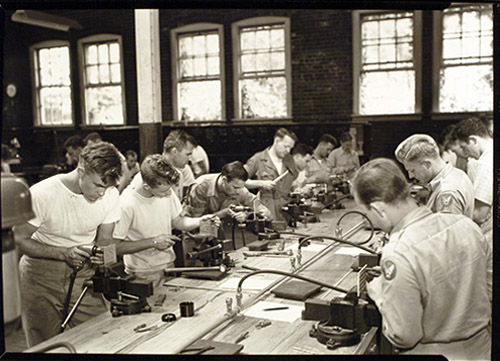
1953
Industrial Engineering
The formation of the department comes from a long history of the discipline being taught at the university, including some courses taught by Lillian Gilbreth, the first lady of engineering, but it is under the supervision of a faculty that has no members with a PhD. Some of the original faculty members would take leaves of absence, at great personal sacrifice, to secure their doctorates from other universities. In 2024, U.S. News & World Report ranked its online graduate program at #1 and undergraduate program at #2 in the U.S.
-
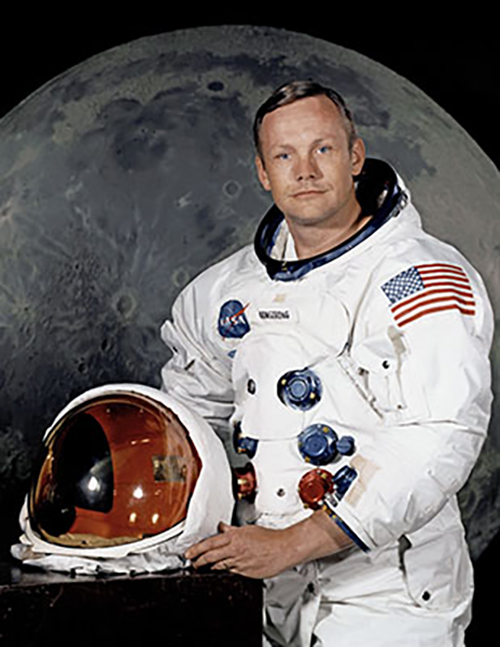
1955
Neil Armstrong (BSAE ’55, Honorary Doctorate ’70)
First person to walk on the moon.
-
1956
Eugene Cernan (BSEE '56, Honorary Doctorate '70)
Last Man on the Moon, Apollo 17 in 1972; second American to walk in space, Gemini 9 in 1966; and pilot of the lunar module of the Apollo 10 mission, the dress rehearsal of the moon landing in which the lunar module would descend to within 8 nautical miles of the moon in 1969.
-
1957
Roger Chaffee (BSAE '57)
Would become an astronaut, but before going to space, would die with Gus Grissom on Jan. 27, 1967, in the Apollo 1 flash fire at Cape Kennedy. Would be awarded posthumously by President Bill Clinton in 1997 the Congressional Space Medal, the U.S. space program's highest honor.
-
1959
Chemical Engineering
The school separates from the metallurgical engineering. Since the name of the School of Chemical Engineering and Metallurgical Engineering, research in metallurgy at Purdue had expanded. In 1942, its PhD program started. In 1951, it became its own division.
-
1960
Nuclear Engineering
The emergence of the Nuclear Engineering School at Purdue occurred in 1960. Many within the initial program had participated in the Manhattan Project, along with other Purdue programs. The program would soon have its own experimental reactor in 1962, PUR-1 – the first and only nuclear reactor operating in Indiana. In 2019 upgraded the reactor and facility as the first entirely digital nuclear reactor instrumentation and control system in the nation.
-

1962
Robert L. Bowen (BSCE ’62)
Bowen Engineering Corporation, founded by Robert Bowen, would become Indiana's leading utility contractor specializing in the construction of wastewater treatment plants, power plants, industrial facilities, and underground utilities. The privately funded current 66,000 square-foot Robert L. and Terry L. Bowen Laboratory for Large-Scale Civil Engineering Research provides the capacity to test full-scale building up to four stories tall.
-
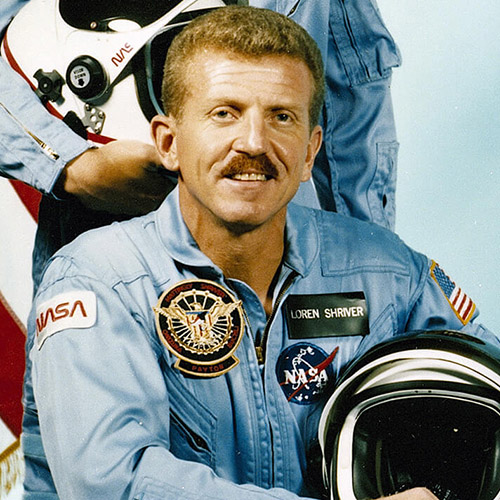
1968
Loren J. Shriver (MSAAE ’68)
Would become a Shuttle Astronaut and command flight 31, which deployed the Hubble Telescope.
-
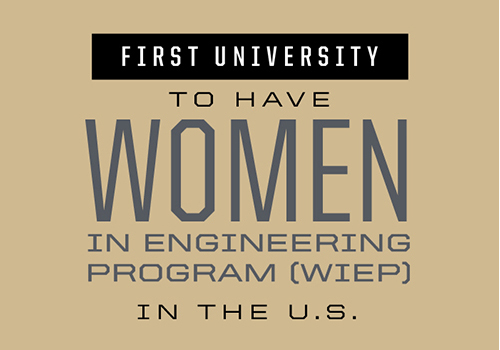
1969
First Women in Engineering Program
Established in 1969, the Purdue Women in Engineering (WiE) Program was the first of its kind in the nation and has been a model for such programs at other universities. Since then, the enrollment of women in the College of Engineering has increased from less than one percent to the current 26 percent. Women now receive 20 percent of the undergraduate engineering degrees granted, up from less than one percent in the early 1970s.
-
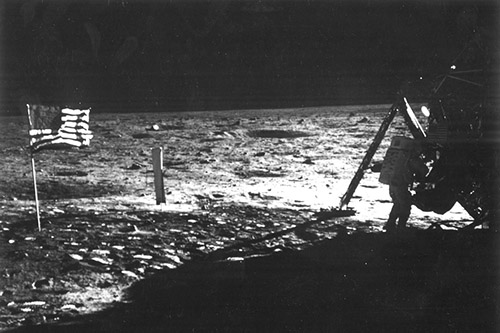
1969
First Step on the Moon
On July 20, 1969, Neil Armstrong became the first human to step foot on the Moon, the highlight of the Apollo 11 mission. Photo credit: NASA
-
1970
Jerry Ross (BSME ’70, MSEE ’72, Honorary Doctorate ’00)
Would become Shuttle Astronaut and come to hold the record for the most spacewalk time.
-
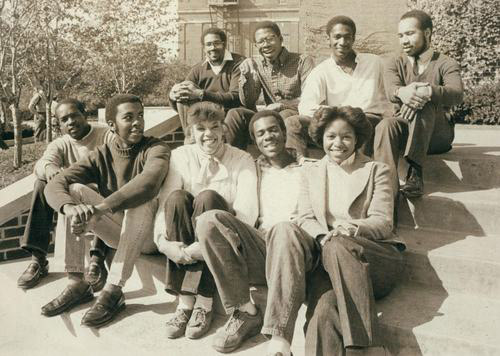
1971
National Society of Black Engineers (NSBE)
In the late 1960s, a devastating 80 percent of the black freshman entering the engineering program dropped out. In 1971, two Purdue undergraduate students, Edward Barnette and Fred Cooper approached the dean of engineering at Purdue University with the concept of starting the Black Society of Engineers. It has grown to more than 600 chapters and more than 24,000 active members in the U.S and abroad.
-
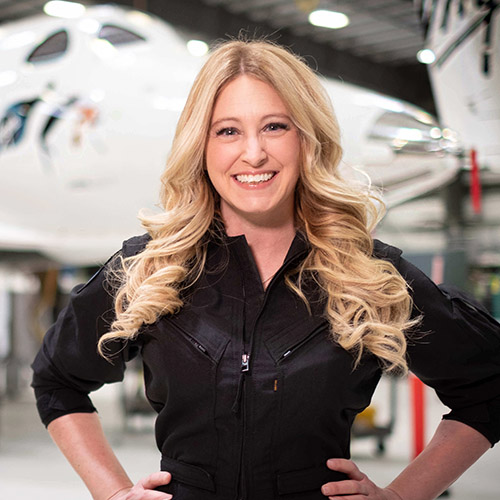
1973
School of Aeronautics and Astronautics Established
Forms from School of Aeronautical Engineering. The name change affirms the significant role astronautics had played in the school since 1957 and would continue to have there and world-wide. Its alumni would lead substantial advances in research and development of aerospace technology, including designing of aircraft, missiles, and space vehicles; heading major corporations and government agencies; and traveling to space as NASA astronauts. Nearly a third of U.S. spaceflights have included a Purdue graduate, and 10-plus missions have included multiple Purdue alums. Purdue alumni are also achieving milestones in space with commercial ventures such as Virgin Galactic, Blue Origin and SpaceX.
-
1973
Materials Engineering
The School of Materials Science and Metallurgical Engineering increases the importance of research in other areas then metallurgy, thus the school renames itself yet again. The school is ranked 11th in the nation with an extensive alumni network, including company presidents and vice-presidents, researchers, business leaders and university professors.
-
1974
World’s Largest Defibrillator
Leslie Geddes joins Purdue's Hillenbrand Biomedical Engineering Center, where, with his research team, he would construct the world's largest defibrillator and establish the second and third laws of defibrillation.
-
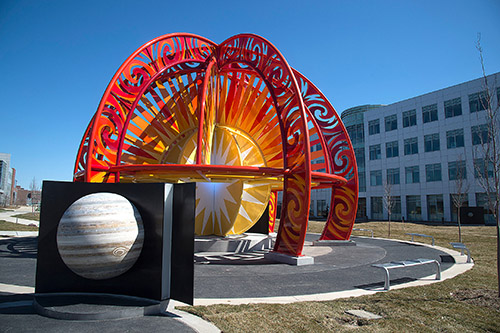
1975
Janice E. Voss (MSES ’75)
Would become a Shuttle Astronaut, logging over 49 days in space, traveling 18.8 million miles in 779 Earth orbits on five space flights. Would become the Science Director for the Kepler spacecraft at NASA Ames Research Center. The VOSS Model, a scaled model of the solar system located in Purdue’s Discovery Park, was dedicated to the late astronaut who passed away in 2012 after battling cancer.
-
1979
Keith J. Krach (BSIE '79)
Would be the co-founder of Ariba, Inc., a leader in business-to-business electronic commerce services and software. In 2017 as CEO of DocuSign, Krach went on a listening trip to explore whether his company should enter the China market. What he experienced there was eye-opening. From that the Krach Institute for Tech Diplomacy at Purdue was founded to ensure that technology advanced freedom, not authoritarianism.
-
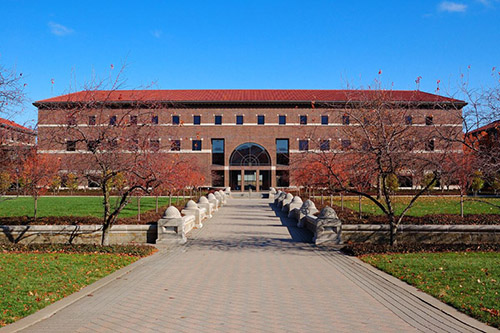
1988
Materials and Electrical Engineering
Is built to house the expanding Schools of Materials and Electrical Engineering.
-
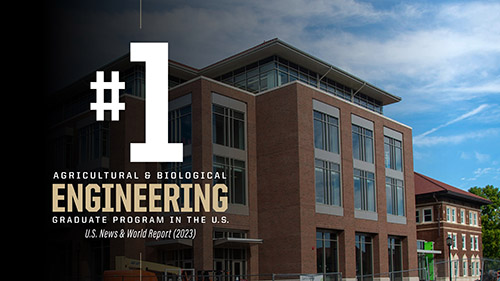
1995
Agricultural and Biological Engineering
Research in agricultural engineering evolves from its focus on the mechanization and automation of American agriculture -- recognized as one of the top 20 engineering achievements of the 20th century by the National Academy of Engineering. The department focuses on the discovery of solutions to critical public issues including safe and sustainable food supplies, environmental protection and energy supplies that are both reliable and renewable. It was ranked the #1 undergraduate and graduate program in 2024 by U.S. News & World Report.
-
1998
Biomedical Engineering
Forms from the Biomedical Engineering Center, also known as the Hillenbrand Center, created in 1972 by a gift from Trustee William A. Hillenbrand along with a subsequent endowment from Grace Showalter, a long-time supporter of Purdue. In 2006, the Biomedical Engineering Building became the first biomed engineering building at a public institution in Indiana.
-
2004
Engineering Education
Marks the first time any university in the country creates an academic department dedicated to engineering education.
-
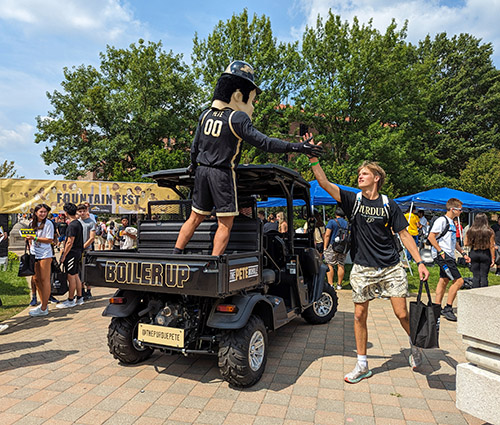
2004
College of Engineering
The current No. 4 engineering program in the nation changes its name from Schools of Engineering, reflecting a shift in the discipline of engineering toward more multidisciplinary, collaborative work where boundaries between specific fields have become less distinct.
-
2006
Division of Environmental and Ecological Engineering (EEE) Established
The Division of Environmental and Ecological Engineering (EEE) was established by the College of Engineering on July 1, 2006. EEE is a unique program from other collegiate programs because it takes an interdisciplinary and synergistic approach to solving challenges at the interface of engineering and the environment. As of 2024, this program ranks 12th among undergraduate and graduate environmental engineering programs nationwide.
-
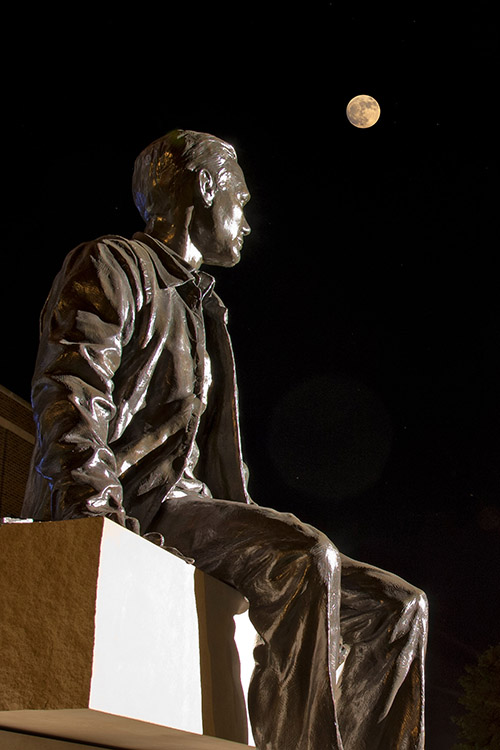
2007
Neil Armstrong Hall of Engineering
Home of the College of Engineering where many students take their first step in the pursuit to become engineers.
-
2014
Global Engineering Programs (GEP)
Most U.S. businesses are global and have employees, value chains and markets extending far beyond U.S. borders Purdue’s Office of Global Engineering Programs and Partnerships helps students through immersive, transformative international experiences. This leads to more effective engineers-graduates who can work effectively across cultural, ethnic and national boundaries and help their employers or their own businesses succeed in an increasingly interconnected world.
-
2015
Lilly Endowment Awards Purdue a $40 Million Grant
Lilly Endowment provides Purdue with a $40 million grant, the largest cash donation in university history, to support initiatives designed to foster groundbreaking research, expand high tech job growth throughout Indiana as well as nationally and globally, and enhance opportunities for students. The grant provides money for the Innovation Design Center, the Flex Lab in Discovery Park and an expansion of the Zucrow Laboratories.
-
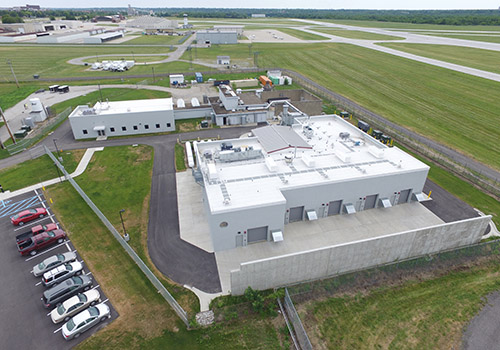
2016
Zucrow Expansion
The expansion will include five new test cells in addition to the two already in place and will support laser-based measurements in a building to be constructed adjacent to Zucrow's high-pressure lab.
-
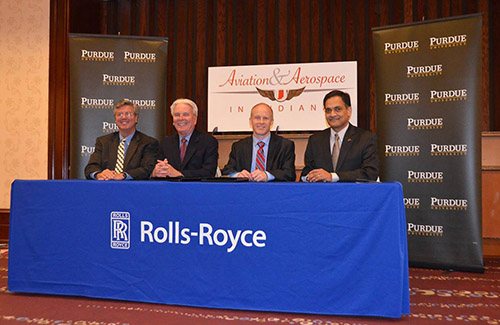
2016
Purdue, Rolls-Royce $33 Million Strategic Partnership
Rolls-Royce and Purdue University will combine resources to form a $33 million jet-engine research and development program to create next-generation aircraft propulsion systems.
-
2016
Nancy Ho Receives Top Award from President Obama
Nancy Ho, founder and president of Green Tech America Inc. and a research professor emerita in the School of Chemical Engineering, received the National Medal of Technology and Innovation from President Barack Obama on May 19.
-
2016
Purdue School of Chemical Engineering to Bear Alumnus Name
Purdue alumnus Charles D. Davidson (BSCE ’72) and his wife Nancy made a $20 million gift to the School of Chemical Engineering and the school will now be named in his honor.
-
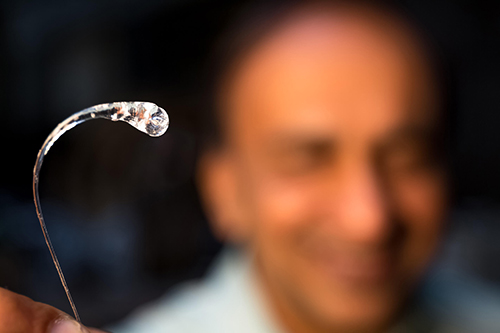
2017
Purdue Researcher Solves Centuries-Old Riddle of Prince Rupert’s
Srinivasan Chandrasekar, professor of industrial engineering, who began his research with Cambridge physicist Munawar Chaudhri more than 20 years earlier, solved the mystery that dates back in the 17th century.
-
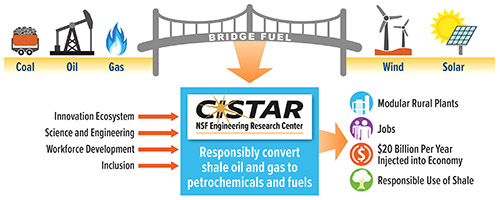
2017
Purdue Chemical Engineering Wins NSF Engineering Research Center
The Center for Innovative and Strategic Transformation of Alkane Resources (CISTAR) will develop new technologies to produce fuels from U.S. shale-gas deposits that could inject $20 billion annually into the economy.
-
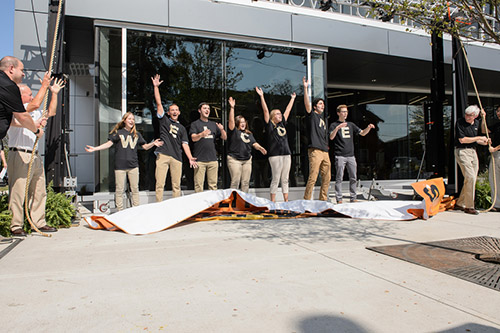
2017
$18.5 Million Dollar Purdue Design Center
The new Bechtel Innovation Design Center is aimed to become a ‘magnet’ where Purdue University students, staff and faculty can move their ideas and innovations to real-world products and impact.
-

2018
Center for Brain-Inspired Computing (C-BRIC)
New SRC-DARPA Center on AI tackles brain-inspired computing.
-

2018
USAID Selects Purdue-lead LASER PULSE Consortium for Global Challenges
Purdue University has been awarded $70 million to lead a consortium to co-create research solutions for developing countries.
-
2019
Manufacturing Design Laboratory Opens
The Manufacturing Design Laboratory, a research space dedicated to the technology-driven future of manufacturing in Indiana and across the globe, is housed in Purdue’s Composites Manufacturing and Simulation Center (CMSC), a part of the Indiana Manufacturing Institute (IMI).
-
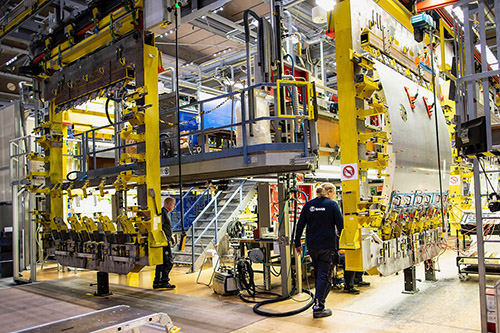
2019
Saab Chooses Major Site at Purdue for Defense Aviation
Purdue University-affiliated Discovery Park District Aerospace will be home to a new aerospace production facility for the U.S. Air Force T-X pilot training program and give flight for future projects. The new facility opened in 2021 representing a major step in both Saab’s global expansion strategy and growth and investment in the U.S.
-
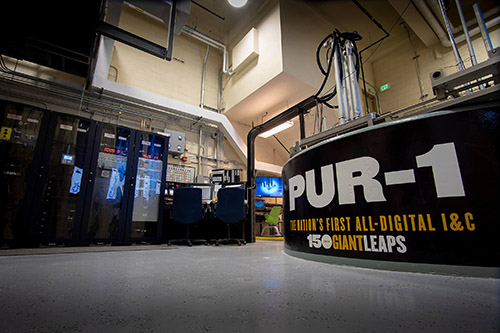
2019
Nation’s First Digitally Operated Nuclear Reactor at Purdue
Purdue University Reactor Number One was converted to digital technology. It supports public and private research partnerships at a first-of-its-kind, digitally operated nuclear reactor, licensed by the U.S. Nuclear Regulatory Commission.
-
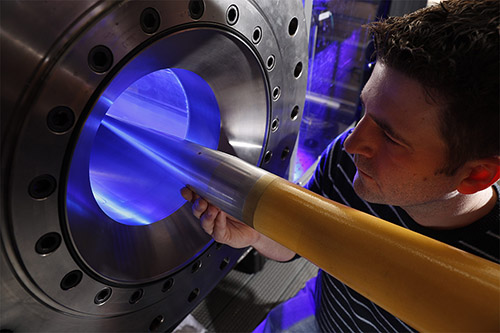
2020
World's First Mach 8 Quiet Wind Tunnel
Purdue University was awarded a $5.9 million contract from the Air Force Research Laboratory to develop the first quiet Mach 8 wind tunnel in the world, further solidifying the state of Indiana’s major role in one of the U.S. Department of Defense’s top technological priorities – the development of hypersonics systems.
-
2020
Advancing Sustainability through Powered Infrastructure for Roadway Electrification (ASPIRE)
The National Science Foundation (NSF) has chosen Purdue University to participate in a new Engineering Research Center dedicated to advancing sustainable, electrified transportation. The five-year, $26 million NSF grant, renewable to 10 years and $50.6 million. The center is expected to raise more than $200 million over the next decade in government and industry support.
-
2020
Purdue to Lead National Workforce Development Project
The Scalable Asymmetric Lifecycle Engagement Microelectronics Workforce Development program (SCALE) is a $19.2 million multi-university public-private-academic partnership that will be used for workforce development across engineering universities across the nation.
-
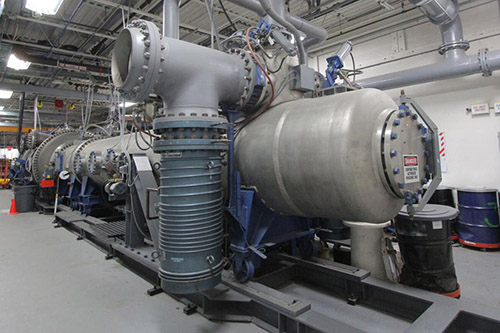
2021
Purdue Trustees Approve Building to House Mach 8 and HYPULSE Wind Tunnels
The Hypersonics and Applied Research Facility will be a 65,000-square-foot facility, capable of housing a Mach 8 wind tunnel and a Hypersonic Pulse (HYPULSE) shock tunnel. The project is estimated to cost $41 million.
-
2021
Purdue EE Alumnus Makes $25 Million Gift to the School of Electrical and Computer Engineering
The school was renamed the Elmore Family School of Electrical and Computer Engineering for the family of alumnus William B. Elmore (BSEE ’75, MSEE ’76).
-
2021
Purdue College of Engineering to Offer Semiconductor Degrees and Programs
The Elmore Family School of Electrical and Computer Engineering (ECE), in partnership with Purdue’s Schools of Mechanical Engineering and Materials Engineering, intends to offer the new concentration—an entirely new Master of Science (MS) degree major in semiconductors and microelectronics—starting in January 2022.
-

2021
'Lab to Life' 6G Digital Innovation Platform Launched
The launch is the next step in creating one of the most connected innovation communities in the nation through the evolution from 5G to 6G.
-
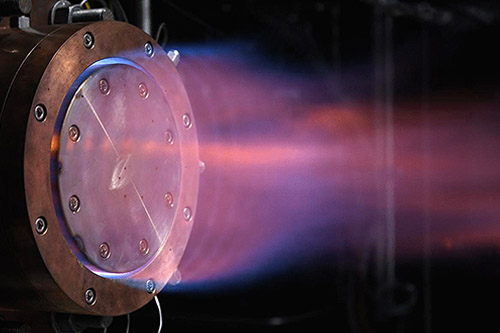
2022
Rolls-Royce and Purdue Sign Strategic Alliance
Purdue and Rolls-Royce officials signed a research and testing agreement brings $75 million over 10 years. The investment will be focused primarily in Purdue’s Zucrow Laboratories.
-
2022
Semiconductors@Purdue
In summer 2022, then-Dean of Purdue Engineering Mung Chiang announced: the launch of the first comprehensive Semiconductor Degrees Program, welcomed the Skywater fab to campus, formed an R&D; partnership with imec, established Purdue as a key collaborator with India Semiconductor Mission, and signed the U.S.-Japan semiconductor agreement at the G7 summit.
-

2023
New Stratolaunch-Purdue Partnership
Stratolaunch LLC and Purdue University announce a partnership dedicated to accelerating the time required to design, build, test and fly hypersonic vehicles. Stratolaunch will establish the Stratolaunch Advanced Programs Office at the Convergence Center in Purdue’s Discovery Park District in West Lafayette, Indiana, to ensure the goals of their collaboration will be rapidly achieved.
-
2023
Mung Chiang Named President of Purdue University
Chiang became Purdue’s 13th president on Jan. 1, 2023. He is also the Roscoe H. George Distinguished Professor of Electrical and Computer Engineering and served as the John A. Edwardson Dean of the College of Engineering from July 2017 to June 2022.
-
2023
Arvind Raman Selected as New Dean of Purdue's College of Engineering
Longtime Purdue University administrator, faculty member and Boilermaker alumnus Arvind Raman is the new John A. Edwardson Dean of the College of Engineering.
-

2023
Dudley and Lambertus Halls Dedicated
The new Gateway Complex brings two disciplines – the College of Engineering and Purdue Polytechnique -- together in a common physical space.
-
2023
AFRL Regional Hub at Purdue
Through the Regional Hub Network, Air Force Research Laboratory (ARFL) scientists and engineers will engage and collaborate with universities, small and large businesses, other government agencies and venture capitalists to assemble a new science and technology ecosystem in which partners help the lab research high-risk case studies.
-
2023
Purdue, imec, Indiana Announce Partnership
Purdue University and the state of Indiana continue to make giant leaps in semiconductor research growth with a first-of-its-kind agreement with European-based imec, a cutting-edge European nano- and digital technology innovation company.
-

2023
Eli Lilly Commits $42.5M to Fund Innovative Pharmaceutical Manufacturing Scholarships
The Lilly Scholars at Purdue program will offer 75-100 talented students each year full tuition with a guaranteed internship or co-op at Lilly and a promise of coordinated interaction with company leaders.
-

2023
Purdue Applied Research Institute (PARI)
PARI, the applied research arm of Purdue University, opened a new facility dedicated to enhancing Purdue’s world-leading capabilities in hypersonics evaluation and testing. The Hypersonics and Applied Research Facility (HARF), a $41 million, 65,000-square-foot building is home to two cutting-edge wind tunnels – the only Mach 8 quiet wind tunnel in the world and the hypersonic pulse (HYPULSE) reflected shock/expansion tunnel. It is also home to the Hypersonics Advanced Manufacturing Technology Center (HAMTC), a single location for industry partners to work on materials and manufacturing innovations and provide access to testing capabilities.
-
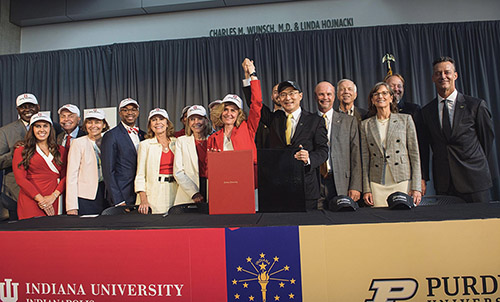
2023
Purdue in Indianapolis Announced
On June 14, 2023, Purdue University trustees and Indiana University trustees simultaneously approved the agreements that will effectively dissolve IUPUI on June 30, 2024, completing a process that started in August 2022. Purdue University in Indianapolis is Purdue’s first comprehensive urban campus.
-
2023
Purdue@Crane
Purdue@Crane will focus on hypersonics, energetic materials and trusted microelectronics. The investment will catalyze and accelerate the existing collaborative research agreements that focus on national security and defense and on semiconductors.
-

2023
eXcellence in Manufacturing and Operations (XMO) Initiative Launched
The XMO PEI will tap Purdue’s domain excellence to build a community of faculty, students and industries at today’s intersection of physical, digital and sustainable manufacturing
-

2023
Engineering to Launch Three New Graduate Degrees
Purdue Engineering’s Professional Master’s Programs will introduce three new specialized professional master’s degrees -- autonomy, Internet of Things (IoT) and robotics -- beginning in the spring 2024 semester. All are based in autonomous and connected systems (ACS) and directly aligned with transformative technological advancements, cutting-edge research and long-term industry needs.
-
2023
Purdue Launches New IN-MaC Node at Purdue University in Indianapolis
To fuel and impact the ongoing manufacturing renaissance and expand its reach across Indiana, Purdue University is launching The Indiana Next-Generation Manufacturing Competitiveness Center (IN-MaC) node at Purdue University in Indianapolis in a joint venture with Purdue’s Manufacturing and Materials Research Laboratories (MMRL).
-
2023
Leading Energy-transition Advances and Pathways to Sustainability (LEAPS) Launched
With the launch of the newest Purdue Engineering Initiative—LEAPS (Leading Energy-Transition Advances and Pathways to Sustainability)—we will step up to a new level of research and education innovation that will cross disciplines, link campus expertise, and empower our future engineers and entrepreneurs.
-
2024
College of Engineering, NobleReach Foundation Announce New Degree Certificate
A groundbreaking partnership to offer a new undergraduate certificate program, Innovation for Public Service. The key objective of the program is to increase the number of engineering graduates entering public service careers, contributing as technology leaders and practical problem solvers.
-

2024
New Online Master's in AI
Interdisciplinary degree takes aim at artificial intelligence skills shortage in the workforce.
-
2024
Purdue University receives $100 million commitment from Lilly Endowment
Lilly Endowment Inc. has approved grants totaling $100 million to Purdue Research Foundation to support two major Purdue University initiatives, which together will elevate the university, its students and faculty and accelerate new investments in Indiana’s workforce and economy.
-

2024
Semiconductor Advanced Packaging
SK Hynix announces nearly $4 billion semiconductor advanced packaging investment in Purdue Research Park.
